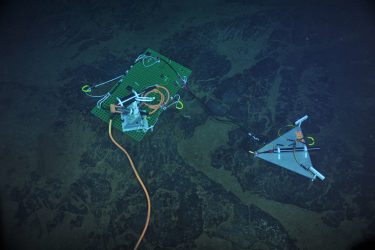
The cracking, bulging and shaking from the eruption of a mile-high volcano where two tectonic plates separate has been captured in more detail than ever before. A University of Washington study published this week shows how the volcano behaved during its spring 2015 eruption, revealing new clues about the behavior of volcanoes where two ocean plates are moving apart.
“The new network allowed us to see in incredible detail where the faults are, and which were active during the eruption,” said lead author William Wilcock, a UW professor of oceanography. The new paper in Science is one of three studies published together that provide the first formal analyses of the seismic vibrations, seafloor movements and rock created during an April 2015 eruption off the Oregon coast. “We have a new understanding of the behavior of caldera dynamics that can be applied to other volcanoes all over the world.”
The studies are based on data collected by the Cabled Array, a National Science Foundation-funded project that brings electrical power and internet to the seafloor. The observatory, completed just months before the eruption, provides new tools to understand one of the test sites for understanding Earth’s volcanism.
Read more at UW Today »
